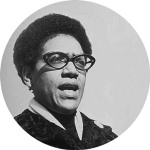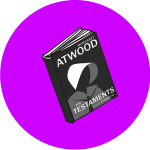Deep Read | 19 March 2020
Feminist Intersections
When our world is in flux, it’s essential to keep our wits about us. That means supplementing our news and respective isolations with art, literature, and deep reading. In that spirit, we’re committed to bringing you ways to think about Margaret Atwood’s The Testaments, and hope you’ll find this program a helpful respite that offers substantive ways to engage with the world in turn.
The responses to our first installment last week have been great. We were struck by an observation shared by Christine in Alameda, who was intrigued by the character names in the book. She writes: “This question occurred to me when I came across the three helpers preparing Agnes for her wedding—Aunts Betty, Lorna, and Sara Lee. I’m assuming they represent 1950s boxed perfection that’s also pretty toxic, but would love to hear more about the other names in this book!” So, readers, let’s take up Christine’s question as a challenge. Send your thoughts about the meaning behind some of the character names in the book. We’ll share some responses next week!
This week we’re going to look at The Testaments from the angle of feminist thought. To help us think about how to best consider this, we sat down with Dr. Marcia Ochoa, professor of Feminist Studies at UC Santa Cruz. Dr. Ochoa finds Atwood’s work—specifically The Handmaid’s Tale (novel and TV show) and The Testaments—to be valuable for teaching and engaging with feminist thought because, as she explains, “these stories make gender oppression very portable. The story stays in your memory and travels with you … Of course, feminism isn’t a single idea or text. It’s a rich field of debate—it’s an approach.”

Reproductive Justice to Intersectionality

In FMST 1: Introduction to Feminism, Ochoa teaches The Handmaid’s Tale alongside Audre Lorde (pictured to the right), the poet, writer, and thinker who came to prominence in the 1970s and whose work was a powerful influence on the currents of feminist thought swirling around when Atwood wrote The Handmaid’s Tale. Lorde, who was a “Black, lesbian, mother, warrior, poet,” has some helpful words in her 1984 essay “The Transformation of Silence Into Language and Action”:
And where the words of women are crying to be heard, we must each of us recognize our responsibility to seek those words out, to read them and share them and examine them in their pertinence to our lives. That we not hide behind the mockeries of separations that have been imposed upon us and which so often we accept as our own.
The Handmaid’s Tale takes the narrative form of recorded and transcribed oral history, narrated in hiding under the oppressive regime of Gilead. Ochoa’s class begins by asking how we take our experiences of oppression and begin to give them language and put them out into the world. Lorde’s invective in this essay gives us a template for having feminist courage in the face of oppression.
One way to approach Atwood’s The Testaments (2019), which is a sequel to The Handmaid’s Tale (1985), is to think about how feminism has changed from the mid-1980s to now. Both novels are told from the point of view of the testimony, a confessional genre, here written by women, that asks readers to consider and examine first-person narratives, possibly for “their pertinence to our lives.” From a feminist perspective, what pertinence do Atwood’s women narrators in The Testaments have to our lives. What are her narrators asking of us as readers? Moreover, is the novel feminist in some way? And what shape does this feminism take?

The Veil
In a moment when the Supreme Court weighs women’s right to abortion in Louisiana—with ramifications for all American women—seeing the world and culture through a feminist lens is very much needed. Perhaps the most iconic image to arise from Gilead, the patriarchal world depicted in The Testaments and The Handmaid’s Tale, is the hood, or veil, worn by the Handmaids. These are women who maintain the ability to give birth and whose role is to live with, procreate with, and carry the babies of the men in power who can’t do so naturally with their own wives. As Dr. Ochoa (pictured below) observes:
The veiling in the books is seen as a white feminist response to Muslim veiling. The aesthetic, though, is drawn from the 16th-and 17th-century Netherlands, where extreme forms of Christianity engaged in veiling practices.
 Atwood herself adds to this assessment, explaining that she drew on broad cultural influences, both religious and commercial, for the veil in The Handmaid’s Tale and The Testaments: “I must confess the face-hiding bonnets came not only from mid-Victorian costume and from nuns, but from the Old Dutch Cleanser package of the 1940s, which showed a woman with her face hidden, and which frightened me as a child. Many totalitarianisms have used clothing, both forbidden and enforced, to identify and control people.”
Atwood herself adds to this assessment, explaining that she drew on broad cultural influences, both religious and commercial, for the veil in The Handmaid’s Tale and The Testaments: “I must confess the face-hiding bonnets came not only from mid-Victorian costume and from nuns, but from the Old Dutch Cleanser package of the 1940s, which showed a woman with her face hidden, and which frightened me as a child. Many totalitarianisms have used clothing, both forbidden and enforced, to identify and control people.”
Another influence that Atwood cites for The Handmaid’s Tale and The Testaments is the alarming division and conflict among women that she started to see in the 1980s when the gains of second-wave feminism—reproductive freedoms, educational and workplace equality, domestic violence and sexual harassment protections—were facing “backlash,” as journalist Susan Faludi coins it. A major source of this backlash was coming from the rise of the Religious Right, a fundamentalist movement that targeted feminism as a source of moral decline and sought to roll back many of its gains, from abortion rights to sexual education policy. Feminism in this 1980s not only saw external attacks but also internal divisions, exemplified in the Feminist Sex Wars, which set anti-porn feminists against sex-positive feminists in intense, often unresolved debates around sexuality, pornography, prostitution, and transgenderism.
Both The Handmaid’s Tale and The Testaments are concerned with what happens to women when they are faced with external and internal forces that undermine and threaten their fundamental rights and freedoms. Will they turn on each other? Will they cooperate? Are they able to cooperate?
As you are reading The Testaments this week, pay attention to how Atwood depicts the relationships among women. How would you characterize their relationships in the novel? Thinking more broadly, how do the feminists concerns of the 1980s and the backlash against them play out in the novel? Are these concerns still prevalent in our society today? If so, how are they evident and where do we see them? What is the role of veiling and clothing in this scenario, both in the book and today?

Seeing the Intersections
Since the fictional world of Gilead was created in the 1980s, feminist thought has gone through quite an evolution. The political, philosophical, and social concerns of women are no longer seen in isolation, but in conversation with interrelated issues of race, class, sexuality, ability, etc. The prevailing term for this—coined by legal scholar and critical race thinker Kimberlé Crenshaw—is intersectionality.
Intersectionality is an approach to feminism that takes into account more vectors of identity than just gender and, as such, complicates earlier, white-dominated, middle-class versions of feminism. What intersectionality suggests is that focusing on gender alone doesn’t explain how our identities work or how discrimination and oppression work. To fully grasp these things, we need to understand that our identities are comprised of overlapping categories and that discrimination and oppression operate at intersections of identity. Thus, each woman experiences discrimination in unique, not uniform, ways. A white, middle-class woman, largely the focus of Atwood’s novels, has a different experience of discrimination than a black, working-class woman.
In The Testaments, we see how, for instance, Aunt Lydia’s overlapping gender and class positions have informed her identity and influenced the way she lives in both pre-and post-Gilead society. In one passage, Aunt Lydia reflects on how her working class background intersects with the gender discrimination and abuse she faced as a child: “Our family having been what it was—trailer-park dwellers, sneerers at the police, consorters with the flip side of the criminal justice system—my father was proud of that. Though not of me: I was a girl and, worse, a smarty pants girl. Nothing for it but to wallop those pretensions out of me, with fists or boots or whatever else was to hand” (112). We might pause here and think about what Atwood is suggesting about Aunt Lydia’s identity. How does this passage construct her identity exactly? How does her social location influence how she responds to the Gilead takeover as well as how she maintains power at Ardua Hall? What role does it play in Aunt Lydia’s relationship to the Gilead regime as the story unfolds? How does the construction of Aunt Lydia’s whiteness inflect her position, and her ability to enforce or subvert the Gilead regime?
When thinking about how The Testaments depicts intersectional identity, we might also want to think about which identities are missing in the novel and why. For instance, in some of the conversations about intersectional identity in Prof. Laura Martin’s class, students have raised questions about the lack of intersectional representation of race in the novel, which we see glimpses of in The Handmaid’s Tale (and more than glimpses of in the TV show). Students have asked questions such as the following: Why is this intersection of racial identity missing here and at what cost? Why might Atwood make such a choice? Does the intersectional feminism in The Testaments speak to the concerns of intersectional feminism today? What do you make of these questions and how do you read The Testaments in the context of contemporary, intersectional feminism?
We hope you’ll keep reading deeply with us, consider some of the questions we’ve posed, and share your observations along the way. Don’t hesitate to drop a note to deepread@ucsc.edu and we’ll share your thoughts back to the community.
Next week, we’ll connect with Dr. Andrew Matthews of UC Santa Cruz’s Anthropology Department and get his take on the implications of demographic and environmental decline on the lives of Atwood’s characters.
Stay attuned,
-The Deep Read Team
|